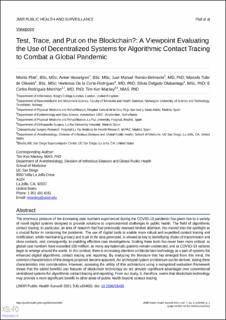| dc.contributor.author | Platt, Moritz | |
| dc.contributor.author | Hasselgren, Anton | |
| dc.contributor.author | Román-Belmonte, Juan Manuel | |
| dc.contributor.author | De Oliveira, Marcela Tuler | |
| dc.contributor.author | De La Corte-Rodríguez, Hortensia | |
| dc.contributor.author | Olabarriaga, Sílvia Delgado | |
| dc.contributor.author | Rodríguez-Merchán, E. Carlos | |
| dc.contributor.author | Mackey, Tim Ken | |
| dc.date.accessioned | 2023-01-20T08:58:39Z | |
| dc.date.available | 2023-01-20T08:58:39Z | |
| dc.date.created | 2021-12-01T13:30:35Z | |
| dc.date.issued | 2021 | |
| dc.identifier.citation | JMIR Public Health and Surveillance. 2021, 7 (4), 1-18. | en_US |
| dc.identifier.issn | 2369-2960 | |
| dc.identifier.uri | https://hdl.handle.net/11250/3044837 | |
| dc.description.abstract | The enormous pressure of the increasing case numbers experienced during the COVID-19 pandemic has given rise to a variety of novel digital systems designed to provide solutions to unprecedented challenges in public health. The field of algorithmic contact tracing, in particular, an area of research that had previously received limited attention, has moved into the spotlight as a crucial factor in containing the pandemic. The use of digital tools to enable more robust and expedited contact tracing and notification, while maintaining privacy and trust in the data generated, is viewed as key to identifying chains of transmission and close contacts, and, consequently, to enabling effective case investigations. Scaling these tools has never been more critical, as global case numbers have exceeded 100 million, as many asymptomatic patients remain undetected, and as COVID-19 variants begin to emerge around the world. In this context, there is increasing attention on blockchain technology as a part of systems for enhanced digital algorithmic contact tracing and reporting. By analyzing the literature that has emerged from this trend, the common characteristics of the designs proposed become apparent. An archetypal system architecture can be derived, taking these characteristics into consideration. However, assessing the utility of this architecture using a recognized evaluation framework shows that the added benefits and features of blockchain technology do not provide significant advantages over conventional centralized systems for algorithmic contact tracing and reporting. From our study, it, therefore, seems that blockchain technology may provide a more significant benefit in other areas of public health beyond contact tracing. | en_US |
| dc.language.iso | eng | en_US |
| dc.publisher | JMIR Publications | en_US |
| dc.rights | Navngivelse 4.0 Internasjonal | * |
| dc.rights.uri | http://creativecommons.org/licenses/by/4.0/deed.no | * |
| dc.title | Test, Trace, and Put on the Blockchain?: A Viewpoint Evaluating the Use of Decentralized Systems for Algorithmic Contact Tracing to Combat a Global Pandemic | en_US |
| dc.title.alternative | Test, Trace, and Put on the Blockchain?: A Viewpoint Evaluating the Use of Decentralized Systems for Algorithmic Contact Tracing to Combat a Global Pandemic | en_US |
| dc.type | Peer reviewed | en_US |
| dc.type | Journal article | en_US |
| dc.description.version | publishedVersion | en_US |
| dc.source.pagenumber | 1-18 | en_US |
| dc.source.volume | 7 | en_US |
| dc.source.journal | JMIR Public Health and Surveillance | en_US |
| dc.source.issue | 4 | en_US |
| dc.identifier.doi | 10.2196/26460 | |
| dc.identifier.cristin | 1962666 | |
| cristin.ispublished | true | |
| cristin.fulltext | original | |
| cristin.qualitycode | 1 | |

